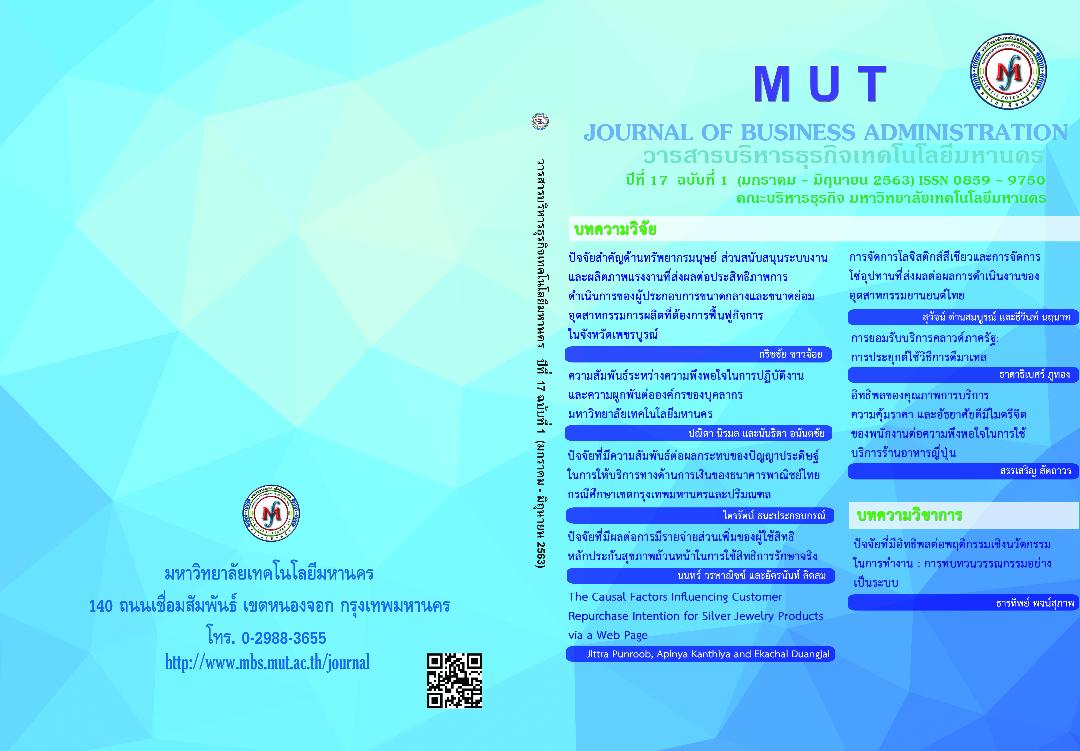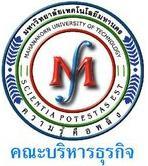The Relationship between Job Satisfaction and Organizational Commitment of Mahanakorn University of Technology’s Employees
Keywords:
Job Satisfaction, Organizational CommitmentAbstract
The objectives of this study were (1) to compare job satisfaction of Mahanakorn University of Technology’s employees classified by their positions, duration of employment, and income levels, (2) to compare the employees’ organizational commitment classified by positions, duration of employment, and income levels, and (3) to study the relationship between job satisfaction and organizational commitment of Mahanakorn University of Technology’s employees.
The samples were 386 employees who work at the Mahanakorn University of Technology. The research instruments were the questionnaires measuring personal factors and job satisfaction. The data were analyzed using a computer package program. The statistical results were shown in percentage, mean, standard deviation, t-test ANOVA analysis, and Pearson Product Moment Correlation. The results of this study indicated that : 1. The employees’ job satisfaction was at a high level. Also, when considering the classifications, it was found that the average of the employees’ satisfaction was at a high level except the salary and benefits and working conditions that showed the employees’ satisfaction at a median level. The comparison of the job satisfaction of Mahanakorn University of Technology’s employees found that the employees with different positions and different incomes had different levels of job satisfaction at 0.05 level of significance. However, the employees with different duration of employment had no difference in job satisfaction. 2. The employees’ organizational commitment was at a high level. Also, when considering the classifications, it was found that the average of the employees’ organizational commitment was at a high level except the continuance commitment that showed the employees’ organizational commitment at a median level. The factors that influenced the employees’ organizational commitment were the affective commitment, normative commitment and continuance commitment, respectively. The comparison of the organizational commitment of Mahanakorn University of Technology’s employees found that the employees with different of the duration of employment had different levels of organizational commitment at 0.05 level of significance. However, the employees with different amount of income had no difference in organizational commitment.
- There was a positive relationship between job satisfaction and organizational commitment of Mahanakorn University of Technology’s employees, generally and in individual aspects.
Downloads
Published
Issue
Section
License
ข้อความ ข้อคิดเห็น ข้อมูล เนื้อหา รูปภาพ แผนภูมิ แผนผัง เป็นต้น ที่ปรากฏและแสดงในบทความต่างๆ ในวารสารบริหารธุรกิจเทคโนโลยีมหานคร ถือเป็นความรับผิดชอบโดยตรงของผู้เขียนบทความนั้นๆ มิใช่เป็นความรับผิดชอบใดๆ ของวารสารบริหารธุรกิจเทคโนโลยีมหานคร และมหาวิทยาลัยเทคโนโลยีมหานคร
บทความที่ตีพิมพ์ในวารสารบริหารธุรกิจเทคโนโลยีมหานคร ถือเป็นลิขสิทธิ์เฉพาะของคณะบริหารธุรกิจ มหาวิทยาลัยเทคโนโลยีมหานคร หากบุคคลหรือหน่วยงานใดต้องการนำทั้งหมดหรือส่วนใดส่วนหนึ่งไปเผยแพร่ต่อหรือเพื่อกระทำการใดๆ จะต้องได้รับการอนุญาตเป็นลายลักษณ์อักษรจากคณะบริหารธุรกิจ มหาวิทยาลัยเทคโนโลยีมหานครก่อนเท่านั้น


